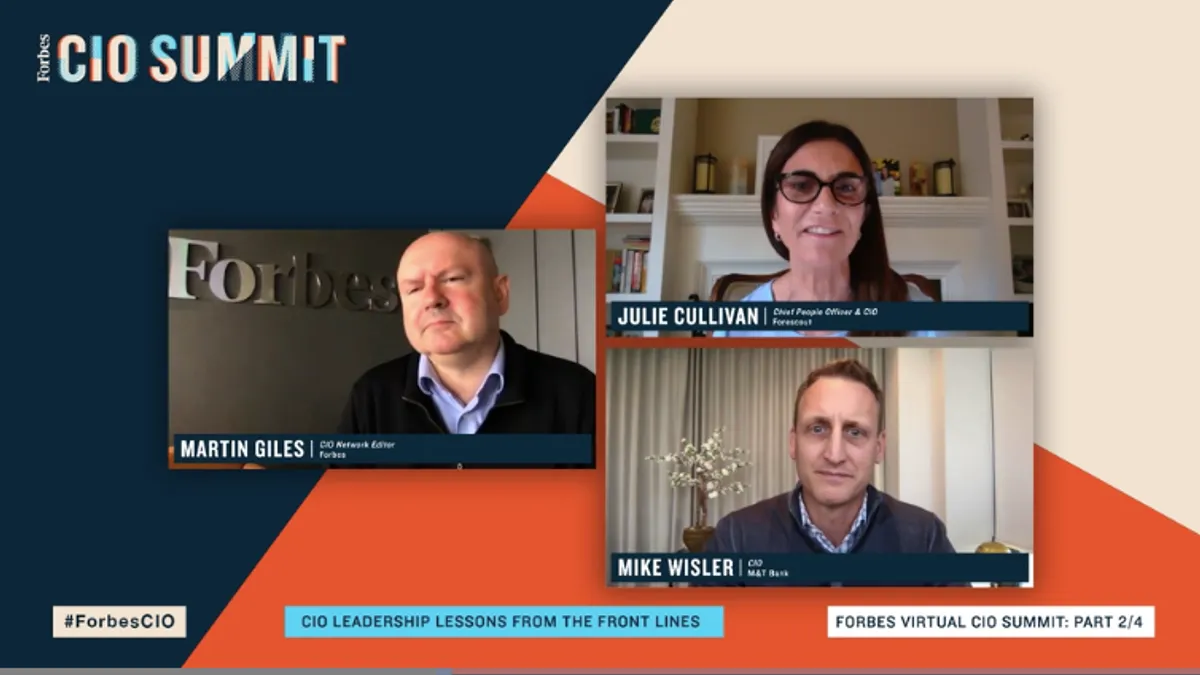The coronavirus pandemic placed new pressures on the CIO and the role technology plays in the business, bridging gaps across a distributed workforce. Efforts centered around collaboration and transformation are now focused on continuing operations in a constrained setting.
"We're living at work" instead of working from home, said Mike Wisler, CIO of M&T Bank, while speaking on a Forbes CIO Summit digital panel last week.
The distinction emphasizes how little control companies had over the rapid transformation of operations. Remote work became a necessity instead of an option, placing new pressures on leadership. Big picture transformation turned to culture and the employee experience.
The next wave of modernization will balance technology upgrades and employees' appetite for change, testing CIOs and other executive leaders on building sustainable operating models that don't alienate workers.
Three technology priorities have emerged out of the pandemic, according Karalee Close, Global Leader, technology advantage at BCG:
-
Securing operations, including safeguards for employees and securing remote work
-
Digital acceleration
-
Business resilience
The coronavirus spurred a wakeup call for digital capabilities at the forefront of the technology stack and 80% of companies expect to accelerate digital transformation efforts, said Close, speaking on a Summit panel. But less than 30% of organizations deliver value at scale, according to BCG data.
While there's a new level of willingness to consider modernization, executing at scale toward "real transformation of companies" is where it matters, Close said. "I think the reality is about culture and change barriers shifting before our eyes."
The pandemic may accelerate what was already in the works. In financial services, e-signatures are becoming the norm and companies are rethinking the role of physical branches.
"We need this opportunity" to take a real step forward, Close said. The "CIO has never been more critical" and is in a unique position to reshape companies reality.
The need is for CIOs to focus on outcomes that drive value in the business, including "resilience in terms of growth and cost reduction," Close said. The real value is about bringing the operating model together and communicating capabilities with business or HR counterparts to highlight the importance and urgency of tech transformation.
Where teams factor in
Enterprises have to rethink how to translate core values.
Businesses didn't choose this scenario, which pushes leaders to pause and think about the challenges to office culture and understand the impact on employees, according to Wisler.
Leaders have to learn a whole new skill set, rethinking engagement and becoming more thoughtful and prescriptive in working with employees, said Julie Cullivan, chief people officer and CIO at Forescout, speaking on the panel. As leadership drives the business, it can't forget the pressure and stress of work from home.
In a role where navigating people and technology intersect, Cullivan has advantages in being able to move quickly, connecting technology and solving personnel constraints in the pandemic.
For example, Forescout has a few critical services requiring people to be on site, presenting the challenge of keeping people safe. While Cullivan has to confront the problem, she also has a team that can build a quick application on an existing platform to solve it.
While Cullivan is in a unique position, other CIOs can coordinate with executive leadership to better understand existing business problems and help navigate solutions.
Addressing team issues start with a culture beyond IT, Cullivan said. IT has to engage with stakeholders and become collaborative. It also requires having conversation with people to understand who is thriving in the remote environment and which employees it's more of a struggle for.
The goal is to get back to a hybrid office model and apply some of the learned benefits from the remote setup, Cullivan said.















